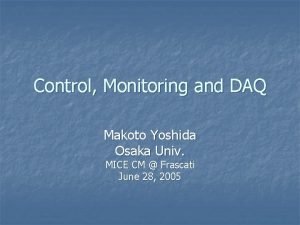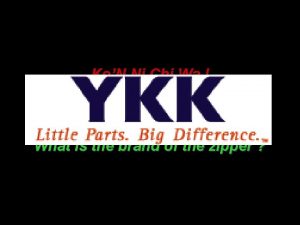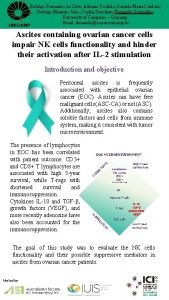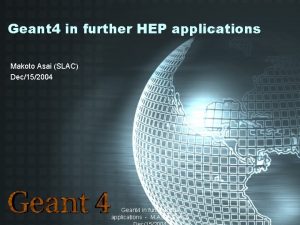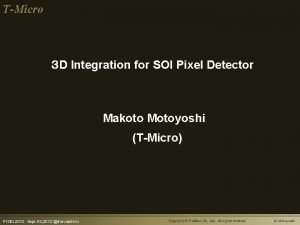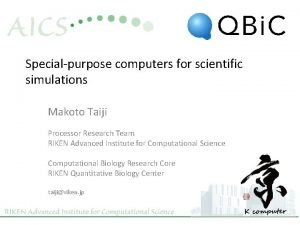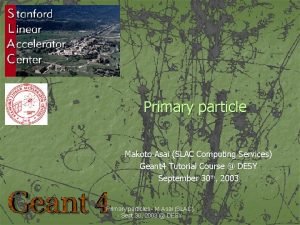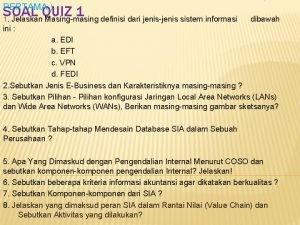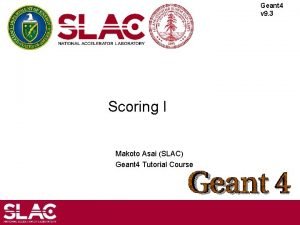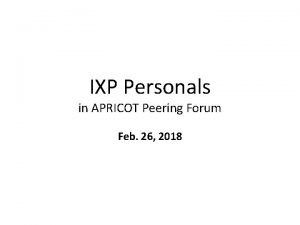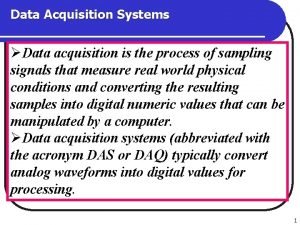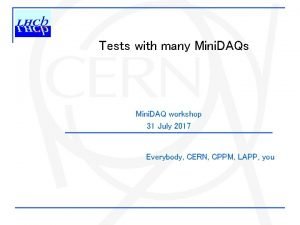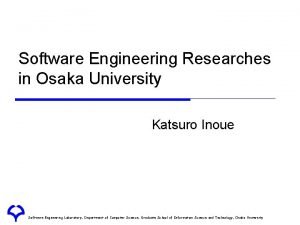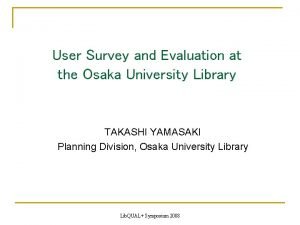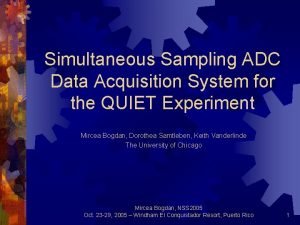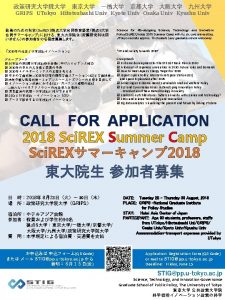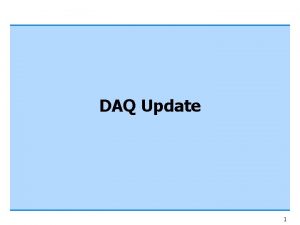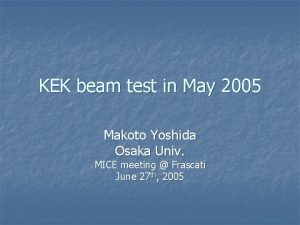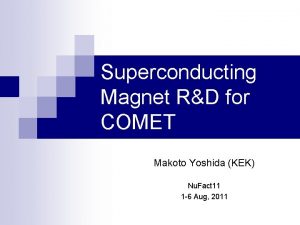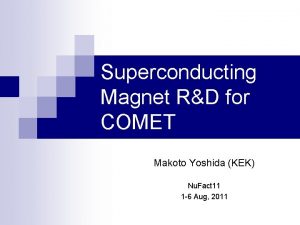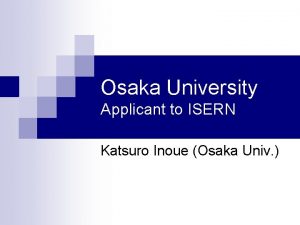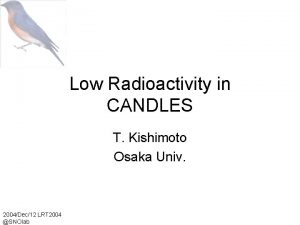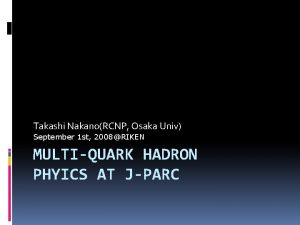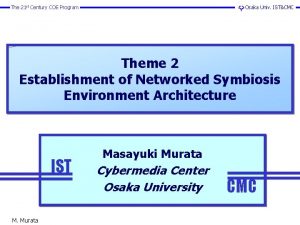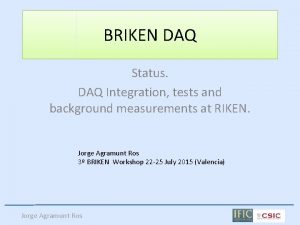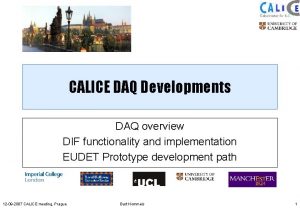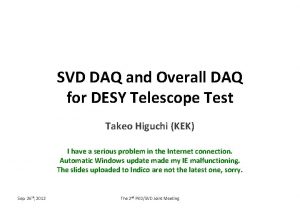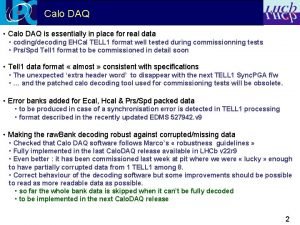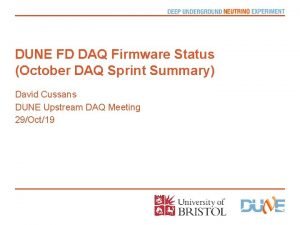Control Monitoring and DAQ Makoto Yoshida Osaka Univ




















- Slides: 20

Control, Monitoring and DAQ Makoto Yoshida Osaka Univ. MICE CM @ Frascati June 28, 2005

Brief history n n n Initiate work on control/monitoring and DAQ in the previous collaboration meeting in Berkeley Edda surveyed on controls, instrumentation and DAQ Jean-Sebastien distribute a draft of a new version of Edda’s note n n “Kick-off” DAQ meeting in lunch time on June 23 n n Jean-Sebastien, Emilio, Paul, Alan, Koji and Makoto Emilio prepared a skeleton for DAQ specification n n DAQ-Terminology. doc DAQrequirements. doc Will need a meeting with accelerator experts for further integration

Prepared by Emilio Radicioni

Categories n DAQ (O(mili-sec), every spill) n Detector-DAQ (O(micro-sec), every trigger with spill#-stamp) n detector data n n Beamline-DAQ n cooling channel n n ADC / TDC RF voltage / phase n oscilloscope or flash ADC n others? protons on target 2 ndary particle intensity monitor Slow control/monitor (O(sec), continuously even when DAQ is not running) n beamline n n cooling channel n n magnet currents / temperature RF temperature LH 2 absorber temperature solenoid currents / temperature detectors n n Temperature HV

DAQ n n Each sub-group is developing stand-alone systems Gather the data stream to the event-builder n n For every particle or for every spill Synchronization between the systems n n Spill number stamp Event numbering in each detector n n Time stamp by common clocks? Need to develop a communication between the standalone systems n n Determine interface/protocol Data structure

Slow control n n Each sub-group develop stand-alone systems Strongly related to safety issue Gather the consoles in a control room Develop a communication between the stand-alone systems, if they need n Need to determine interface/protocol

An idea of the DAQ architecture 4 k. Bytes/event Bit 3 SASeq#1 SASeq#2 SASeq#3 SASeq#4 SERDES#1 SERDES#2 SERDES#3 SERDES#4 SERDES#5 SERDES#6 SERDES#7 SERDES#8 Bit 3 1553 VLPC #1 L VLPC #1 R VLPC #2 L VLPC #2 R VLPC #3 L VLPC #3 R VLPC #4 L VLPC #4 R Downstream Tracker 4096 ch Upstream Tracker 4 k. Bytes/event Cryosat Ctrl/Monitor Tracker Collector Downstream Tracker Collector Upstream Tracker Slow Ctrl Beam Builder PID Builder 8 MBytes/spill Tracker Builder Tracker Control MICE Storage MICE Builder MICE Control 4 MBytes/spill

Key issues n Instruments for each sub-group n n Voltage controller/monitor HV controller/monitor n n n Socket on TCP/IP Log files on common directory … Integration n n VME ADC/TDC … Communication between stand-alone systems n n CAENET Event-builders Event numbering Unified interface or distributed controls to stand-alone systems … Offline database

Summary n n DAQ group start to discuss on the integration Need to fill the documents on DAQ specification n Description on the systems of each sub-group Integration, Synchronization To build up MICE control/monitor and DAQ system, communication with accelerator experts is mandatory n Workshop in RAL?


Survey on Controls, Instrumentation and DAQ 1. 2. 3. 4. PHYSICS PARAMETERS: Which parameters might it be important to include in the data analysis of the experiment? CONTROL/MONITORING: Which additional parameters are needed for control or monitoring? How do you see these parameters being recorded and controlled? What need do you have for stand-alone operation as opposed to integrated operation in MICE at RAL? MICE CM Berkeley 9 -12 Feb. 05

Beam & Target (Drumm) l CM Parameters For all magnets Qs(9), Ds(2), decay solenoid: Current l Volts l Temperature, Cryogenics, Vacuum l Target: l l Insertion time Operational monitors: l l Local integrated System for beam To TDC ? ISIS Machine start Line and target. ISIS clock Useful for trigger Insertion depth (read every 0. 1 ms to adapt drive currents and timing) PC/VME/PLC EPICS/Lab. View 8 temperature measurements/cycle Extra needs @ RAL Beam line independent from MICE Target testing away from RAL MICE CM Berkeley 9 -12 Feb. 05

Cooling Channel - Absorber l CM parameters (from TRD) Temperature (Cryocooler, Absorber, temperature systems) Liquid level Buffer vacuum pressure Pressure at key points in H 2 system Valve status in H 2 system Heater currents Window location (? ) H 2 gas system and He gas system l Pressure gauge (capacitance-type); 1 each l Pirani gauge; 1 each LH 2 reservoir at 1 st stage of Cryocooler l 2 Thermometers l 1 Level sensor (capacitance-type) l 2 Heater (1 for spare) Hydrogen absorber l 8 Thermometer l 1 Level sensor Absorber windows l 1 Thermometer l Heater; 1 each (to warm up) Safety windows l Thermometer; 1 each Absorber vacuum and Safety vacuum l Pressure gauge (capacitance type); 1 each l Pirani & cold cathode gauge; 1 each l Mass spectrometer; 1 each MICE CM Berkeley 9 -12 Feb. 05

Cooling Channel - RF Cavities (Virostek) l CM parameters Cavity position and alignment with respect to solenoid Cavity temperature Sensing loop signal from each of the 8 cavities Vacuum roughing pump control (2 each) Vacuum roughing valve control and status (2 each) Cryo pump ion gages (4 total) Vacuum manifold thermocouple and ion gages (4 each total) Vacuum vessel ion gages (2 per vessel, 4 total) Cavity ion gages (8 total) Cryo pump compressor control (2 each) ~1 Hz recording rate Gate valve control and status (4 each) Goes to primary control system Cavity body temperature thermocouple (2 per cavity, 16 total) Cavity cooling fluid temperature in (8 total) Cavity cooling fluid temperature out (8 total) Cavity cooling fluid pressure in (1 per cavity pair, 4 total) Cavity cooling fluid pressure out (1 per cavity pair, 4 total) Cavity cooling flow rate (8 total) Tuner hydraulic reservoir pressure (8 each) Tuner hydraulic reservoir pressure control (8 each) [feedback & control from cavity frequency] MICE CM Berkeley 9 -12 Feb. 05

Cooling Channel - Magnets l CM parameters: Current in each individual supply Magnetic field at external probes (4 probes/coil) Temperatures (cryocooler and coil) Quench protection (? ) MICE CM Berkeley 9 -12 Feb. 05

CKOV 1 (Cremaldi) l Physics parameters l DAQ CM parameters l Noise levels-pedestal Random pedestal trigger Photoelectron count- 4 channel + 1 spare Single electron photo-peak Muon bunch structure Device efficiency vs. muon position Laser pulse system trigger (shared with CKOV 2) PM Tube HV – 4 channels + 1 spare Box temperature Purge gas flow Freon level CAEN/Lecroy HV Alarm System PLC (slow control) visual ? ? Extra needs@ RAL Oscilloscope ADC card + PC External trigger line Radioactive source trigger + logic Trigger paddles + logic for muon response survey MICE CM Berkeley 9 -12 Feb. 05

CKOV 2 (Gregoire) l Physics parameters 8 responses of PMs to light pulses l Pedestal, gain 1 digital output for triggering light pulser 8 TDC outputs l CM parameters 8 HV Temperature probe He pressure Humidity MICE CM Berkeley 9 -12 Feb. 05

TOF (Bonesini) l Physics parameters l Pedestal CM Parameters HV Temperature Magnetic field MICE CM Berkeley 9 -12 Feb. 05

Em. CAL (Tortora) l Physics parameters l Pedestals CM parameters HV of PMs ( CAEN SY 527, CAENNET VME Controller V 288 for remote control) Residual B field Global Time Offset ( Trigger formation time with respect to ISIS bunch warning) l Extra needs @ RAL Stand-alone readout system Cosmic rays run for E, t, calibration MICE CM Berkeley 9 -12 Feb. 05

Sci. Fi (Bross) l Physics parameters Pedestal Gain Discriminator threshold l CM Parameters 72 Temperature 64 Bias l DAQ Extra needs @ RAL Via FE electronics board, stored via MICE slow control system. 8 temperatures for cryostat, interfaced differently. Separate calibration runs MICE CM Berkeley 9 -12 Feb. 05
 Makoto yoshida
Makoto yoshida Kon ni chiwa
Kon ni chiwa Marla yoshida
Marla yoshida Ruriko yoshida
Ruriko yoshida Adriana yoshida
Adriana yoshida Neutorino
Neutorino Motoyoshi
Motoyoshi Makoto pipeline
Makoto pipeline Makoto asai
Makoto asai Jelaskan pengertian gi dan makoto
Jelaskan pengertian gi dan makoto Define makoto
Define makoto Makoto asai
Makoto asai Remote peering in osaka
Remote peering in osaka Data acquisition
Data acquisition Mini daq
Mini daq Tadao ando osaka
Tadao ando osaka Osaka university computer science
Osaka university computer science Bls game
Bls game Seino logix co. ltd
Seino logix co. ltd Osaka university library
Osaka university library Simultaneous data acquisition
Simultaneous data acquisition
